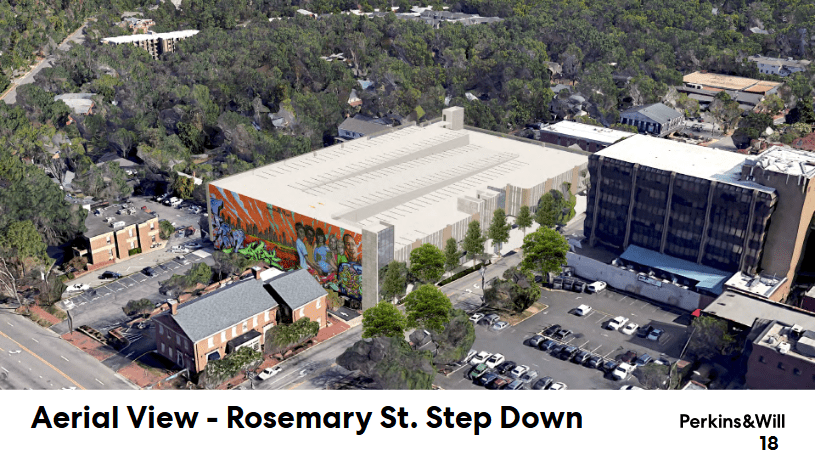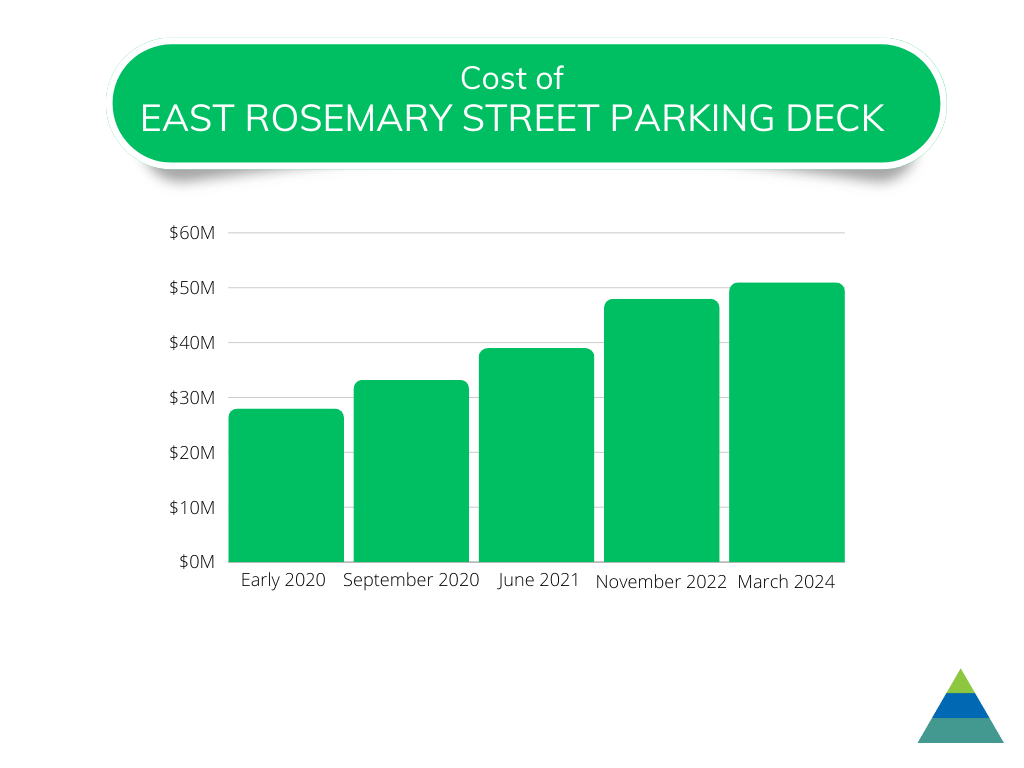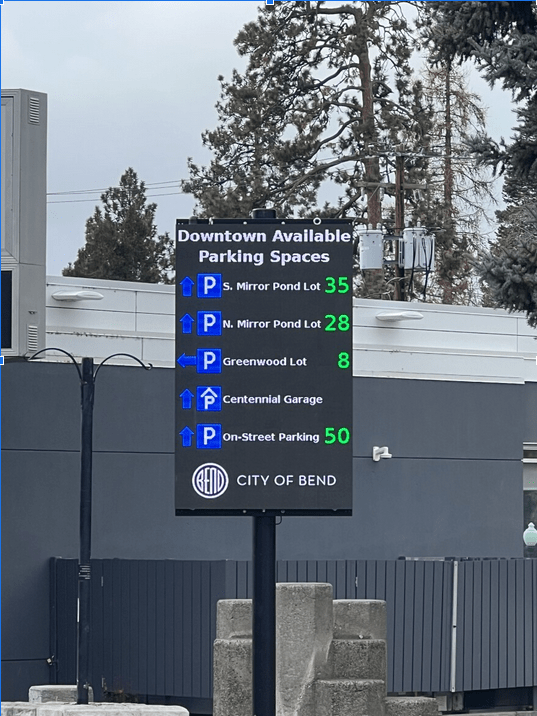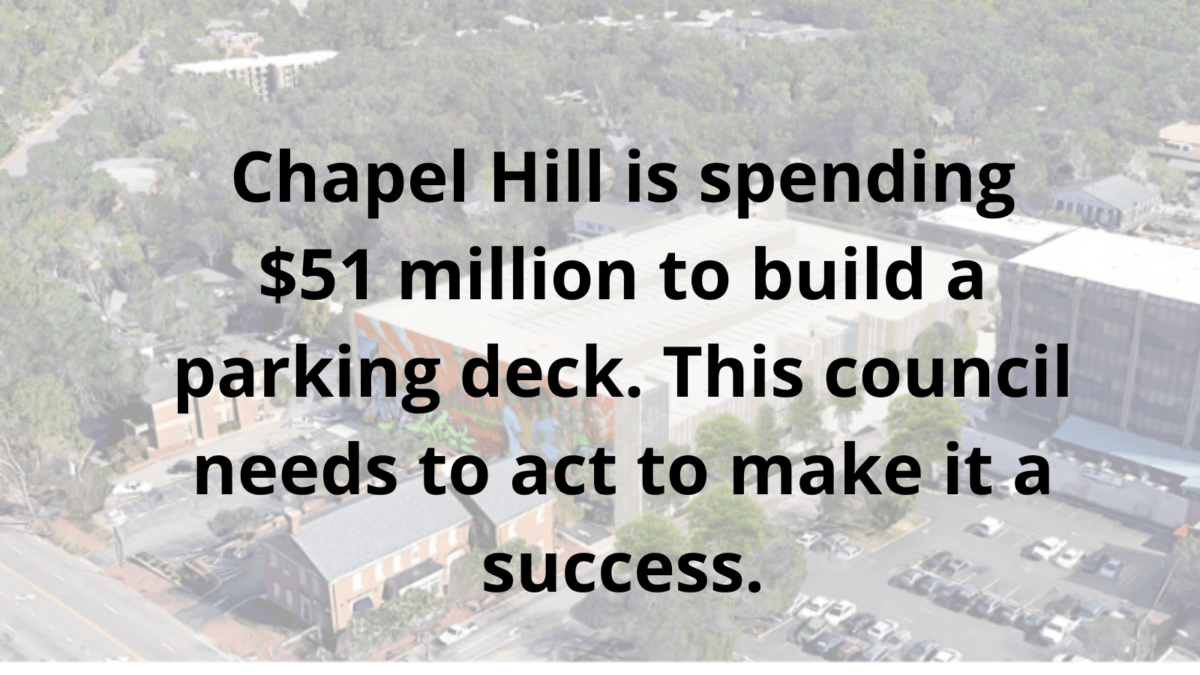This spring will see the completion of the first major new building project in downtown Chapel Hill in almost a decade.
No, it’s not one of the two wet labs the previous councils have approved in recent years. It’s also not the single downtown apartment building the previous council approved last year, after spending more than a year playing hardball with a friendly developer while interest rates skyrocketed. (And, as a signal to other developers thinking of investing money in our community, the previous council rejected three other proposals to build housing elsewhere downtown).

Instead, this spring will see the completion of the East Rosemary Parking Deck. Approved in September 2020, championed by council members in the 2021 election, the cost of building the parking deck has steadily risen. The 1,100-space deck was only going to cost $28 million when it was first discussed in early 2020, $33.2 million when it was approved by council in September 2020, $39 million when a construction contract was approved by the council in June 2021, and $48 million when unanticipated issues with the site’s bedrock were discovered, forcing another vote in November 2022.

This week, the council will vote on whether to borrow an additional $3 million to finish the deck. According to a staff memo, the town is able to pay for these additional costs by using money allocated elsewhere (“March 2023 streets & sidewalks and affordable housing bonds and the Municipal Services Center now permanently on hold”). In addition, the cost increases means that it will be almost a decade before the parking deck even begins to “pay for itself,” as former Mayor Pam Hemminger promised in 2021.
When it was presented to the town council in 2020, the East Rosemary Parking Deck was the cornerstone of an economic revitalization strategy led by Grubb Properties, a developer best known locally for its redevelopment of Glen Lennox, that included a wet lab and a new apartment building. While the council approved both projects—the apartment building, reluctantly—a recent article in the Triangle Business Journal hints that it might be years before Grubb begins construction, as the company is waiting for better financial markets.
Two other approved but not built projects, a hotel at the corner of Rosemary and Columbia, and the Longfellow wet lab further down Franklin, appear to be also caught in the same financial uncertainty. The Washington Post reported earlier this month on the glut of lab space in Boston, repeatedly using a word—empty—that tends to strike fear in the hearts of real estate investors.
Chapel Hill made a big bet on parking. We need a strategy to make sure it pays off.
It’s obvious to anyone that downtown Chapel Hill, particularly the 100-block of East Franklin, is at a turning point. The opening of the East Rosemary Parking Deck was supposed to be the first note in a crescendo of development, with construction cranes moving in all directions to build a downtown that was no longer dependent on the appetites of hungry undergraduates and Game Day visitors.
Now that’s not happening, at least not right away. Moreover, the architect of this downtown strategy, Dwight Bassett, who has served as Chapel Hill’s economic development director for the past fifteen years, is retiring, and the town will soon begin a search for his replacement.
This gives the town, and the town council, an opportunity to think about what they want the future of our downtown to be. We think making the parking deck a success—by which, we mean full—should be a top priority.
Here are some rough calculations that show the difference between a fully occupied deck (parking experts recommend that parking decks should be 85 percent occupied, or 20 hours/day) and one that is, well, not. In all of these I assume that the town will charge $2 an hour to park in the deck, and that the deck has 1100 spaces. (The town currently charges $1.50/hour to park in its existing decks, but that number is scheduled to go up. The deck is expected to have between 1000 and 1100 spaces.)
| Hours occupied per day | 2 | 4 | 8 | 12 | 16 | 20 |
| Daily revenue per space | $4 | $8 | $16 | $24 | $32 | $40 |
| Daily revenue total | $4,400 | $8,800 | $17,600 | $26,400 | $35,200 | $44,000 |
| Annual revenue | $1,606,000 | $3,212,000 | $6,424,000 | $9,636,000 | $12,848,000 | $16,060,000 |
| Years to repay $51 million costs | 31.76 | 15.88 | 7.94 | 5.29 | 3.97 | 3.18 |
Currently, the town charges downtown residents just $195/month, or just over $6/day, for 24-hour parking, which is less than what UNC charges. If we can make sure the new deck is at least 50 percent occupied, we’d be able to quickly pay back construction costs and put us on a path to making parking a source of revenue for the town, not the drain on town coffers that it has been in the past.
Here are a few ideas for how we can make the East Rosemary deck a success:
Raise the price of on-street parking. A lot.
Read any book or study about parking, and you’ll learn that people are highly sensitive to price. If street parking is free, and it’s a dollar an hour to park in the garage, people will circle and circle to find a free spot, wasting time and creating unnecessary traffic.
But raise the price of street parking to a market-clearing rate—we think that might be $3 or $4 an hour in Chapel Hill—and people will scurry to the new garage.
If it’s too hard to change the price of the meters, an alternative might be to red-bag them when parking is in high demand, allowing for short-term parking and curbside pickup, sending everyone else to the garage.
Make the new garage free for the first hour.
Again. People are price sensitive. You can make the first hour free, and start charging the usual rate in the second hour. People will stay downtown for three or four hours, making the enticement worth it.
Invest in digital wayfinding.

As we understand it, the new deck will have technology that will be able to track the exact number of empty spaces in the deck. While there will likely be a sign in front of the deck letting visitors know how many spaces are available, we should also invest in digital wayfinding signs elsewhere, like on Franklin Street, that let visitors know that parking is available and nearby.
Invest in signs, signs, and more sign.
If we’re spending $51 million on a parking deck, we should spend a substantial amount of money promoting it. Put a sign on every block letting people know where to park. Rent a skybeam to advertise the deck. Do what it takes.
Make East Rosemary Street a destination.
Close off part of the street every week and have a party. Invite food trucks on the weekends. Book outdoor concerts. Show movies. Invite artists to do an installation in the Wallace deck, which is scheduled for demolition. We have a creative community. Let’s see it on East Rosemary..
Preemptively zone the land near the deck to entice new development.
While several lots near the new parking deck have already been claimed by the projects listed above, many others have not. If you look at a map of the land around the deck you’ll notice a mishmash of colors and stripes, all indicating different land use rules with contradictory meanings. For example, did you know there’s a parking lot in the historic district? (Apologies to Lana Del Ray).
In 2022, the Chapel Hill Town Council worked with the consultant Jennifer Keesmaat to develop a “complete community framework” that asks the council to think holistically about development. At the end the council was supposed to work on a “pilot project” that allowed them to show how they could move away from parcel-by-parcel development.
Given how much money the town has invested in the parking deck, and the uncertain fate of the nearby projects they have approved, this seems like a golden opportunity to work with designers, architects, and others to create a plan for this block of Rosemary that embodies the town’s aspirations.
Having nearby parking that can be reserved for future residents will make it easier to build more car-free and car-light buildings. Let’s take advantage of this investment. Remove the parking lot from the historic district. Explore building housing and a park on the town-owned land at the corner of Rosemary and Columbia. Work with the owner of 157 E. Rosemary to develop a project that the council can be proud of. Allow for denser housing on North Street that will help create regular customers for downtown businesses.
A parking deck will not save Chapel Hill. But we can’t let it ruin us either.
As we’ve noted before, Chapel Hill does not suffer from a lack of parking downtown, but it does not do a great job managing the parking it has. (Carrboro does an even worse job managing its parking, but tomorrow night they’re discussing a plan to change that).
Under previous generations of leaders, Chapel Hill has fallen into the predictable parking trap, with councils spending millions of dollars annually to subsidize parking that fails to make anyone happy. We still do misguided things like make parking free for holiday shopping, when the entire point of charging for parking is to encourage turnover. (The customer who buys a latte and pastry and sits for 10 minutes is more valuable than the one who buys a coffee and stays for an hour because they quickly free up a table for the next paying customer. Philadelphia recently ended the practice of free holiday parking for exactly this reason.)
While the town now has a good parking services manager in Michael Carew, the council needs to empower him and town staff to carry out the best practices for parking. In a memo to the town, town staff lists a few of them:
- Removed the Parking Fee chart from the budget process so that we are on a path to market-based parking.
- Changed our monthly parking fees to 12-hour increments to improve income from these users. This also prepares us for a shared parking system when we have a balance between residential and office users.
- Committed to over-leasing our monthly parking spaces to maximize income.
- We are also collecting and sharing data to better monitor our overall parking system and to better manage the overall system.
- We are in an aggressive mode of promoting our parking system through social media, ads, and stories around our parking system. The goal is to gain better occupancy on underperforming lots and to encourage higher utilization of all parking spaces.
Making these changes, particularly transitioning to market-based parking, can be challenging, but it’s essential if we want the parking deck to actually pay for itself. For too many years, we’ve allowed ourselves to believe that downtown Chapel Hill’s fate is tied to parking, not to the places we actually go. With a new deck, we finally have the opportunity to imagine a different future for ourselves, one that includes parking, but is not shaped by it.

